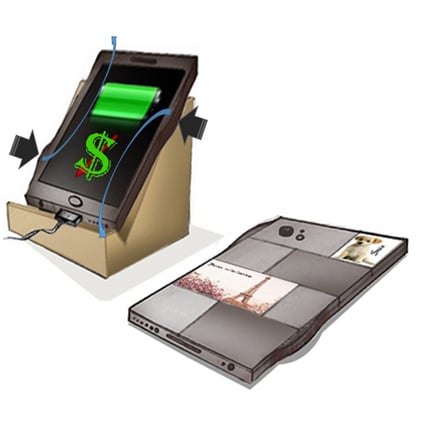Bridging the Gap between Eco-Design and the Human Thinking System
Abstract
:1. Introduction
1.1. Supply-Side Strategies
1.2. Human- or User-Centered Strategies
2. Methods and Materials
3. Results and Discussion
3.1. Development of the SBD Framework
3.2. Application of SBD Framework—Smartphone Case Study
3.2.1. Goal 1: Reducing Purchase Frequency
3.2.2. Goal 2: Reducing Energy Consumption
3.2.3. Goal 3: Minimizing Physical Damage
3.2.4. Goal 4: Encouraging Sustainable End of Life Management
3.3. Smartphone Reimagined with the SBD Framework
4. Conclusions
Acknowledgments
Author Contributions
Conflicts of Interest
References
- Norman, D. The Design of Everyday Things; Basic Books, Inc.: New York, NY, USA, 1998. [Google Scholar]
- Fitzpatrick, C.; Olivetti, E.A.; Miller, T.R.; Roth, R.; Kirchain, R. Conflict minerals in the compute sector: Estimating extent of tin, tantalum, tungsten, and gold use in ICT Products. Environ. Sci. Technol. 2014, 49, 974–981. [Google Scholar] [CrossRef] [PubMed]
- Chancerel, P.; Rotter, S. Recycling-oriented characterization of small waste electrical and electronic equipment. Waste Manag. 2009, 29, 2336–2352. [Google Scholar] [CrossRef] [PubMed]
- Babbitt, C.W.; Kahhat, R.; Williams, E.; Babbitt, G.A. Evolution of product lifespan and implications for environmental assessment and management: A case study of personal computers in higher education. Environ. Sci. Technol. 2009, 43, 5106–5112. [Google Scholar] [CrossRef] [PubMed]
- Deng, L.; Babbitt, C.W.; Williams, E. Economic-balance hybrid LCA extended with uncertainty analysis: Case study of a laptop computer. J. Clean. Prod. 2011, 19, 1198–1206. [Google Scholar] [CrossRef]
- Williams, E. Energy intensity of computer manufacturing: Hybrid analysis combining process and economic input-output methods. Environ. Sci. Technol. 2004, 38, 6166–6174. [Google Scholar] [CrossRef] [PubMed]
- Williams, E.; Ayres, R.; Heller, M. The 1.7 kg microchip: Energy and chemical use in the production of semiconductors. Environ. Sci. Technol. 2002, 36, 5504–5510. [Google Scholar] [CrossRef] [PubMed]
- Williams, E.; Kahhat, R.; Allenby, B.; Kavazanjian, E.; Kim, J.; Xu, M. Environmental, social, and economic implications of global reuse and recycling of personal computers. Environ. Sci. Technol. 2008, 42, 6446–6454. [Google Scholar] [CrossRef] [PubMed]
- U.S. Environmental Protection Agency (EPA). Electronic Waste Management in the United States; Office of Solid Waste, EPA: Washington, DC, USA, 2010.
- Pierce, J.; Fan, C.; Lomas, D.; Marcu, G.; Paulos, E. Some consideration on the (in) effectiveness of residential energy feedback systems. In Proceedings of the 8th ACM Conference on Designing Interactive Systems, Aarhus, Denmark, 16–20 August 2010; pp. 244–247.
- Ryen, E.G.; Babbitt, C.W.; Tyler, A.C.; Babbitt, G.A. Community ecology perspectives on the structural and functional evolution of consumer electronics. J. Indust. Ecol. 2014, 18, 708–721. [Google Scholar] [CrossRef]
- Rodriguez, E.; Boks, C. How design of products affects user behaviour and vice versa: The environmental implications. In Proceedings of the Environmentally Conscious Design and Inverse Manufacturing, 2005. Eco Design 2005. Fourth International Symposium on, Tokyo, Japan, 12–14 December 2005; pp. 54–61.
- Roth, K.W.; McKenney, K. Energy Consumption by Consumer Electronics in U.S. Residences; final report prepared for the Consumer Electronics Associations; TIAX LLC.: Cambridge, MA, USA, 2007. [Google Scholar]
- Ryen, E.G.; Babbitt, C.W.; Williams, E. Consumption-weighted life cycle assessment of a consumer electronic product community. Environ. Sci. Technol. 2015, 49, 2549–2559. [Google Scholar] [CrossRef] [PubMed]
- Köhler, A.; Erdmann, L. Expected environmental impacts of pervasive computing. Human Ecol. Risk Assess. 2004, 10, 831–852. [Google Scholar] [CrossRef]
- Malmodin, J.; Moberg, A.; Lundén, D.; Finnveden, G.; Nina Lövehagen, N. Greenhouse gas emissions and operational electricity use in the ICT and entertainment & media sectors. J. Indust. Ecol. 2010, 14, 770–790. [Google Scholar]
- Wever, R.; Van Kuijk, J.; Boks, C. User-centered design for sustainable behaviour. Int. J. Sust. Eng. 2008, 1, 9–20. [Google Scholar] [CrossRef]
- Bhamra, T.; Lilley, D.; Tang, T. Sustainable use: Changing consumer behaviour through product design. In Proceedings of the Changing the Change: Design Visions, Proposals and Tools, Turin, Italy, 10–12 July 2008.
- Stanton, N.A.; Baber, C. Designing for consumers: Editorial. Appl. Ergonom. 1998, 29, 1–3. [Google Scholar] [CrossRef]
- Lilley, D.; Wilson, G. Intregrating ethics into design for sustainable behaviour. J. Design Res. 2013, 11, 278–299. [Google Scholar] [CrossRef]
- Wever, R. Editional: Design research for sustainable behavior. J. Design Res. 2012, 10, 1–6. [Google Scholar]
- Lilley, D. Design for sustainable behaviour: Strategies and perceptions. Design Stud. 2009, 30, 704–720. [Google Scholar] [CrossRef] [Green Version]
- Clark, G.; Kosoris, J.; Hong, N.L.; Crul, M. Design for sustainability: Current trends in sustainable product design and development. Sustainability 2009, 1, 409–424. [Google Scholar] [CrossRef]
- Graedel, T.E.; Allenby, B.R. Design for Environment; Prentice Hall: New Jersey, NJ, USA, 1996. [Google Scholar]
- Electronics Product Assessment Tool (EPEAT). Available online: http://www.epeat.net (accessed on 17 December 2015).
- Fitzpatrick, C.; Hickey, S.; Schischke, K.; Maher, P. Sustainable life cycle engineering of an integrated desktop PC; A small to medium enterprise perspective. J. Clean. Prod. 2014, 74, 155–160. [Google Scholar] [CrossRef]
- Degeler, A. Fairphone 2 hands-on: Modular phones are finally here. Arstechnica, 22 October 2015. Available online: http://arstechnica.com/gadgets/2015/10/fairphone-2-hands-on-modular-phones-are-finally-here/ (accessed on 19 February 2016).
- Lobos, A.; Babbitt, C.W. Integrating emotional attachment and sustainability in electronic product design. Challenges 2013, 4, 19–33. [Google Scholar] [CrossRef]
- Kahhat, R.; Kim, J.; Xu, M.; Allenby, B.; Williams, E.; Zhang, P. Exploring e-waste management systems in the United States. Resour. Conserv. Recycl. 2008, 52, 955–964. [Google Scholar] [CrossRef]
- Brown, T. Change by Design; Harper Business: New York, NY, USA, 2009. [Google Scholar]
- Drury, C.G. Can HF/E professionals contribute to global climate change solutions? Ergonom. Design 2014, 10, 30–33. [Google Scholar] [CrossRef]
- Human-Centered Design. Available online: https://www.ideo.org/hcd (accessed on 17 December 2015).
- Lilley, D.; Lofthouse, V.A.; Bhamra, T.A. Towards instinctive sustainable product use. In Presented on 2nd International Conference in Sustainability, Creating the Culture, Aberdeen Exhibition & Conference Centre, Aberdeen, UK, 2–4 November 2005.
- Lockton, D.; Harrison, D.; Holley, T.; Stanton, N.A. Influencing interaction: Development of the design with intent method. In Proceedings of the 4th International Conference on Persuasive Technology, Claremont, CA, USA, 26–29 April 2009; p. 5.
- Lofthouse, V. Ecodesign tools for designers: Defining the requirements. J. Clean. Prod. 2006, 14, 1386–1395. [Google Scholar] [CrossRef]
- Selvefors, A.; Pedersen, K.B.; Rahe, U. Design for sustainable consumption behaviour—Systematising the use of behavioural intervention strategies. In Proceedings of the DPPI 11, the 5th Conference on Designing Pleasurable Products and Interfaces, Milan, Italy, 22–25 June 2011; pp. 19–26.
- Boks, C. Design for sustainable behaviour research challenges. In Proceedings of the EcoDesign 2011 International Symposium, Kyoto, Japan, 30 November–2 December 2011; pp. 328–333.
- Lockton, D.; Harrison, D.; Stanton, N.A. The Design with intent method: A design tool for influencing user behavior. Appl. Ergonom. 2010, 41, 382–392. [Google Scholar] [CrossRef] [PubMed] [Green Version]
- Hanratty, M.; Bhmra, T.; Mitchell, V. Digital design for sustainable behaviour: A conceptual framework to guide design intervention. In Proceedings of the HCI 2012, The 26th BCS Conference on Human Computer Interaction, Birmingham, UK, 12–14 September 2012.
- Hanratty, M. Design for Sustainable Behaviour: A Conceptual Model and Intervention Selection Model for Changing Behaviour through Design. Ph.D. Thesis, Loughborough University, Loughborough, UK, 2015. [Google Scholar]
- Lockton, D.; Harrison, D.; Stanton, N. Making the user more efficient: Design for sustainable behavior. Int. J. Sust. Eng. 2008, 1, 3–8. [Google Scholar] [CrossRef] [Green Version]
- Bloch, P.H. Seeking the ideal form: Product design and consumer response. J. Market. 1995, 59, 16–29. [Google Scholar] [CrossRef]
- De Vries, M.J. Ethics and the complexity of technology: A design approach. Phil. Reform. 2006, 71, 118–131. [Google Scholar] [CrossRef]
- Siegle, L. Your home may be hurting the planet. Guardian Unlimited. 8 June 2006. Available online: http://observer.theguardian.com/shellenergy/story/0,,1793286,00.html (accessed on 17 December 2015).
- Scott, F. Behaviour change—Believing you can make a difference. In Proceedings of the BTCV, Global Action Plan and The Environment Council Workshop, London, UK, 20 July 2004.
- Huang, E.M.; Truong, K.N. Breaking the disposable technology paradigm: Opportunities for sustainable interaction design for mobile phones. In Proceedings of the SIGCHI Conference on Human Factors in Computing Systems, Florence, Italy, 5–10 April 2008; pp. 323–332.
- Thaler, R.H.; Sunstein, C.R. Nudge: Improving Decisions about Health, Wealth, and Happiness; Yale University Press: New Haven, CT, USA, 2008. [Google Scholar]
- Crosbie, T. Household energy consumption and consumer electronics: The case of television. Energ. Policy 2008, 36, 2191–2199. [Google Scholar] [CrossRef]
- Kok, R.; Benders, R.; Moll, H.C. Measuring the environmental load of household consumption using some methods based on input–output energy analysis: A comparison of methods and a discussion of results. Energ. Policy 2006, 34, 2744–2761. [Google Scholar] [CrossRef]
- Huijbregts, M.; Rombouts, L.; Hellweg, S.; Frischknecht, R.; Hendriks, A.J.; van de Meent, D.; Ragas, M.J. Is cumulative fossil energy demand a useful indicator for the environmental performance of products? Environ. Sci. Technol. 2006, 40, 641–648. [Google Scholar] [CrossRef] [PubMed]
- Weidema, B.P.; Bauer, C.; Hischier, R.; Mutel, C.; Nemecek, T.; Reinhard, J.; Vadenbo, C.O.; Wernet, G. The Ecoinvent Database: Overview and Methodology, Data Quality Guideline for the Ecoinvent Database Version 3. 2013. Available online: www.ecoinvent.org (accessed on 15 December 2015).
- Mugge, R.; Schifferstein, H.N.J.; Schoormans, J.P.L. Personalizing product appearance: The effect on product attachment. In Proceedings of the 4th International Conference on Design and Emotion, Ankara, Turkey, 12–14 July 2004.
- Kolko, J.; Connors, C. Thoughts on Interaction Design, 2nd ed.; Morgan Kaufmann Publishers: Burlington, MA, USA, 2010. [Google Scholar]
- Waters, R. Design with hearts. In Building Design Strategy: Using Design to Achieve Key Business Objectives, 1st ed.; Thomas Walton, T., Thomas Lockwood, T., Eds.; Allworth Press: New York, NY, USA, 2008; p. 272, Chapter 4. [Google Scholar]
- Green, W.; Jordan, P.W. Human Factors in Product Design: Current Practice and Future Trends; CRC Press: Boca Raton, FL, USA, 1999. [Google Scholar]
- Singhal, P. Integrated Product Policy Pilot Project—stage I, Final Report; Life Cycle Environmental Issues of Mobile Phones: Espoo, Finland, 2005. [Google Scholar]
- Santavaara, I.; Paronen, N. Nokia’s product life cycle assessment over the years, including challenges and key findings. In Proceedings of the 6th International Conference on Life Cycle Management, Gothenburg, Sweden, 25–28 August 2013.
- Intlekofer, K.; Bras, B.; Ferguson, M. Energy implications of product leasing. Environ. Sci. Technol. 2009, 44, 4409–4415. [Google Scholar] [CrossRef] [PubMed]
- AT&T. Available online: http://www.att.com (accessed on 29 December 2015).
- Chapman, J. Attachments with objects. In Emotionally Durable Design; Earthscan: London, UK, 2005. [Google Scholar]
- Keating, L. Can Charging Cases Shorten a Smartphone Battery’s Lifespan? Available online: http://www.techtimes.com/articles/115529/20151211/charging-phones-battery-shorten-life.htm (accessed on 11 December 2015).
- Hill, S. Should You Leave Your Smartphone Plugged into the Charger Overnight? We Asked an Expert. Available online: http://www.digitaltrends.com/mobile/expert-advice-on-how-to-avoid-destroying-your-phones-battery/#ixzz3vqqy4Pha (accessed on 31 January 2015).
- Schaub, F.; Seifert, J.; Honold, F.; Müller, M.; Rukzio, E.; Weber, M. Broken display broken interface: The impact of display damage on smartphone interaction. In Proceedings of the 32nd Annual ACM Conference on Human Factors in Computing Systems, Chicago, IL, USA, 26 April–1 May 2014; pp. 2337–2346.
- U.S. EPA. U.S. EPA Launches National Cell Phone Recycling Week: April 6–12/AT&T, Samsung, Sprint, T-Mobile, and Verizon Wireless Helping Recycle. 6 April 2009. Available online: http://www.epa.gov (accessed on 17 December 2015). [Google Scholar]
- Electronics Waste Management in the United States through 2009; U.S. EPA: Washington, DC, USA, 2011; EPA 530-R-11-002.
- Saphores, J.D.M.; Nixon, H.; Ogunseitan, O.A.; Shapiro, A.A. How much e-waste is there in US basements and attics? Results from a national survey. J. Environ. Manag. 2009, 90, 3322–3331. [Google Scholar] [CrossRef] [PubMed]
- Brown, R.; Webber, C.; Koomey, J. Status and future directions of the energy star program. Energy 2002, 27, 505–520. [Google Scholar] [CrossRef]
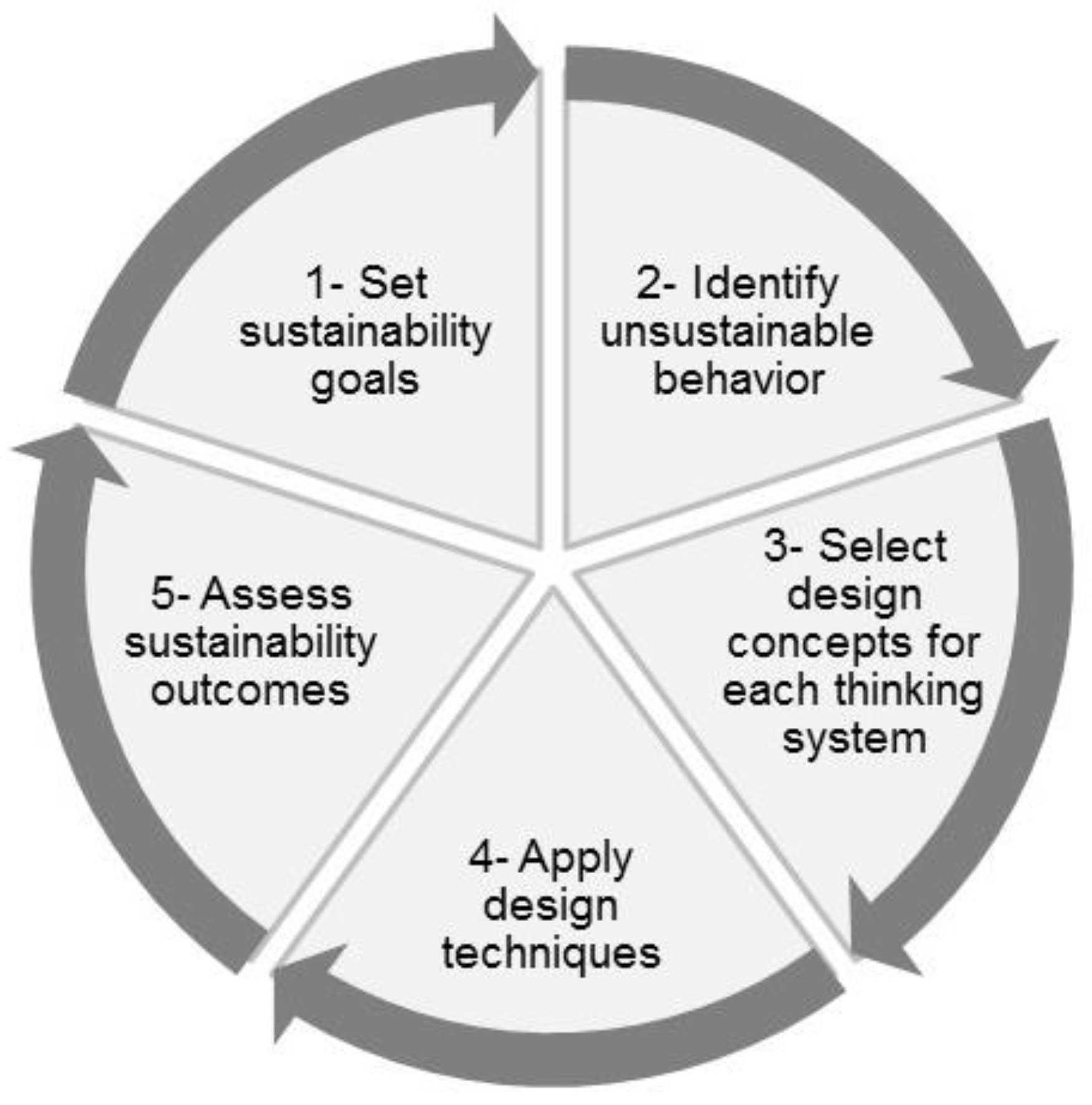
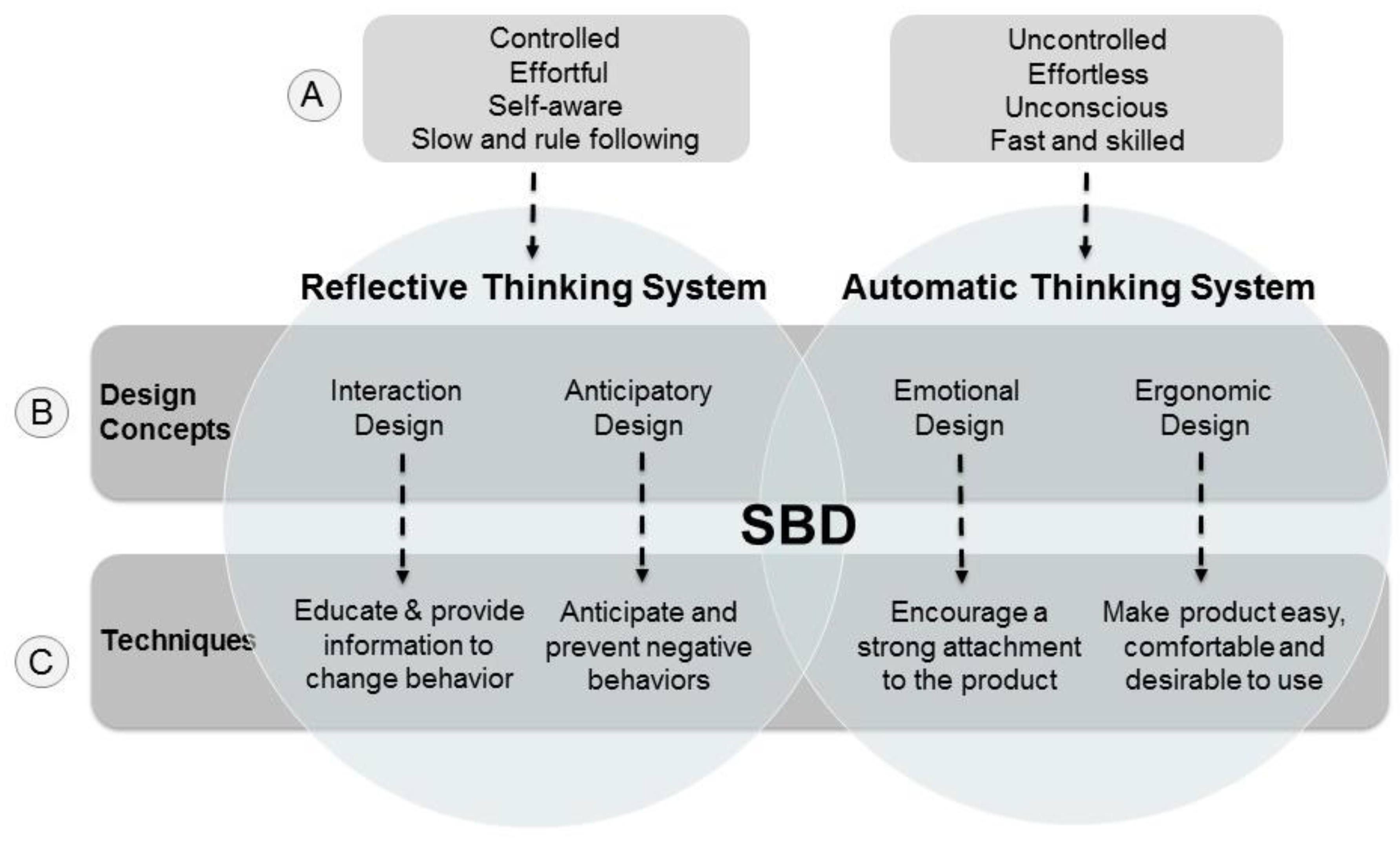
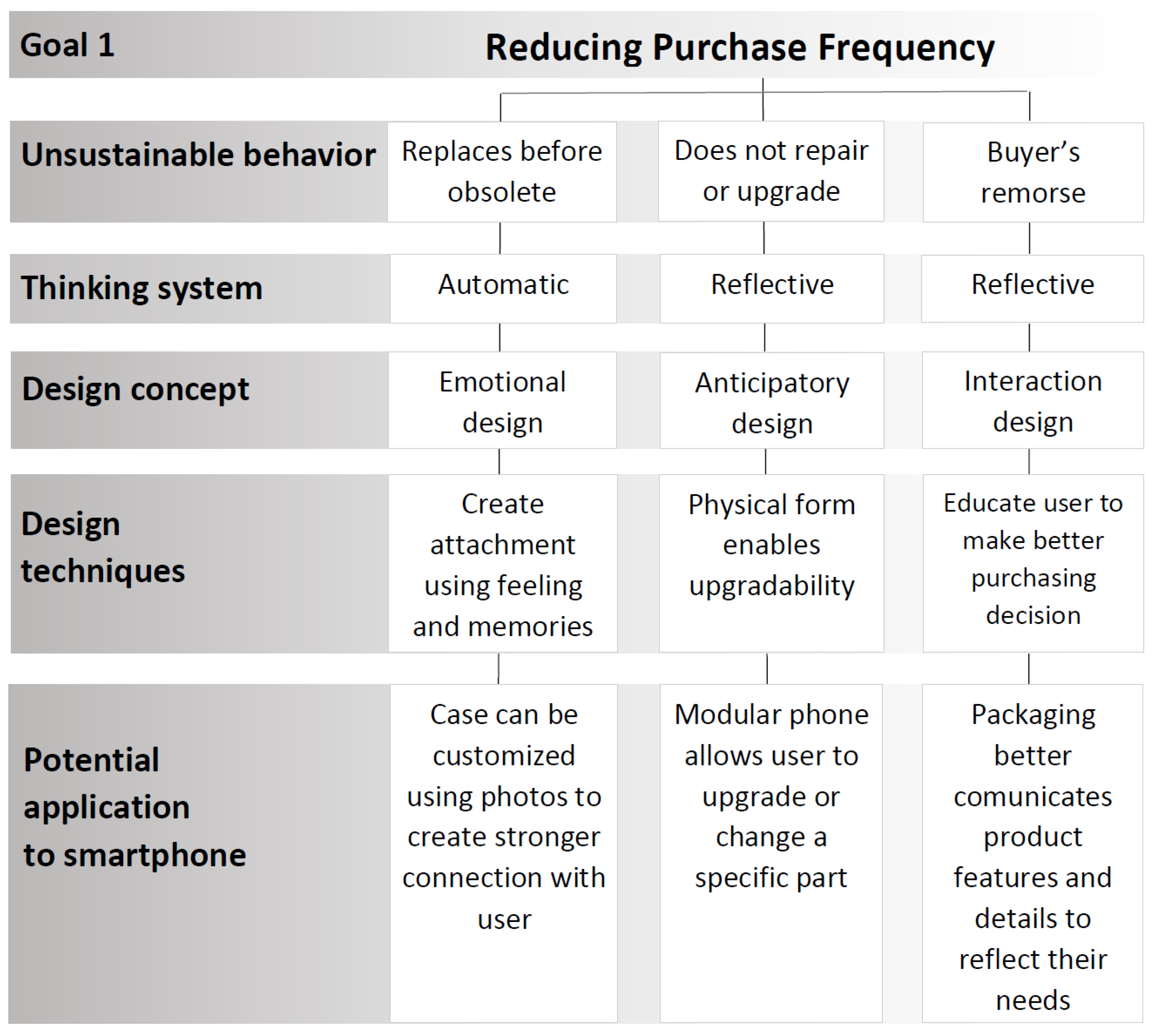
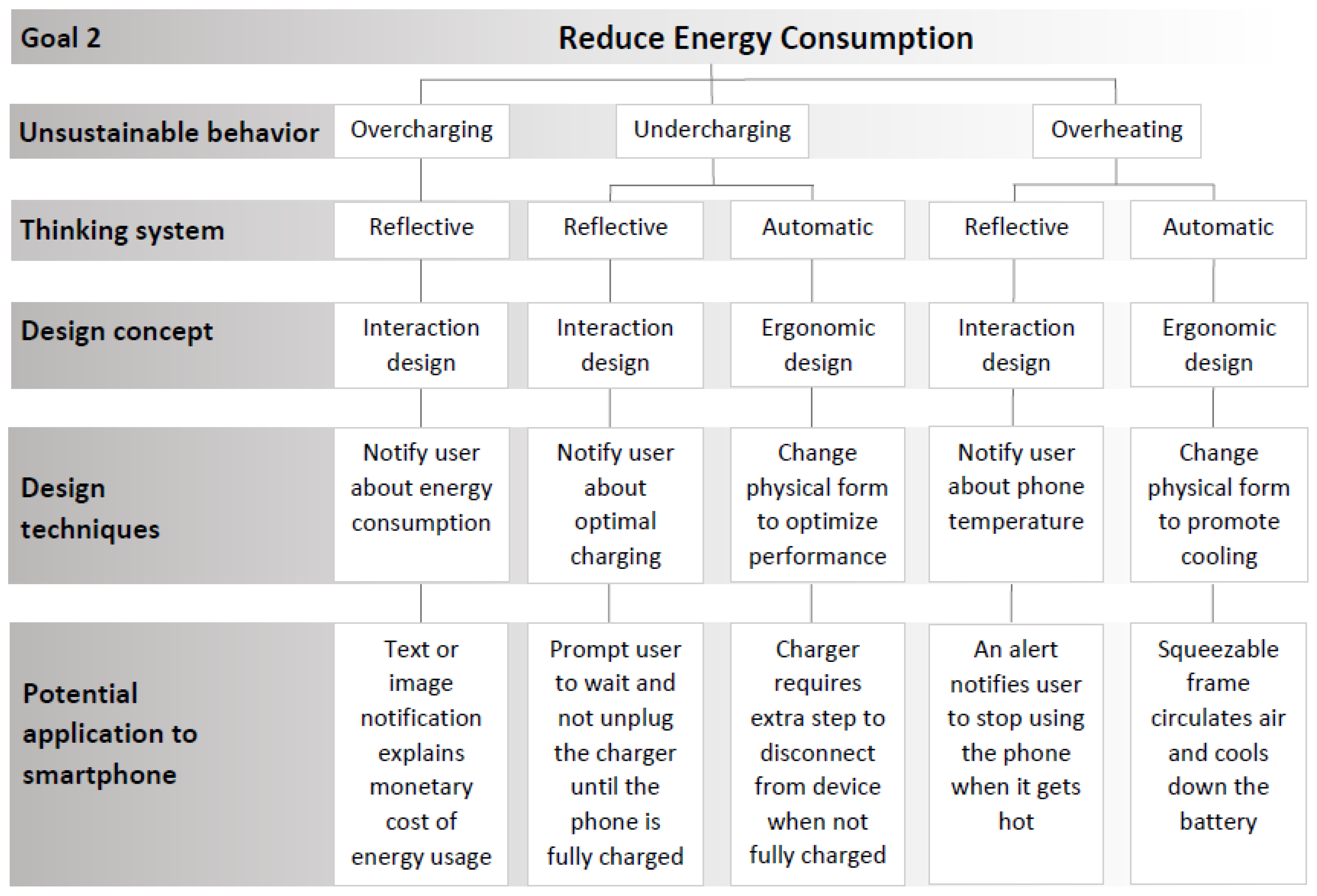


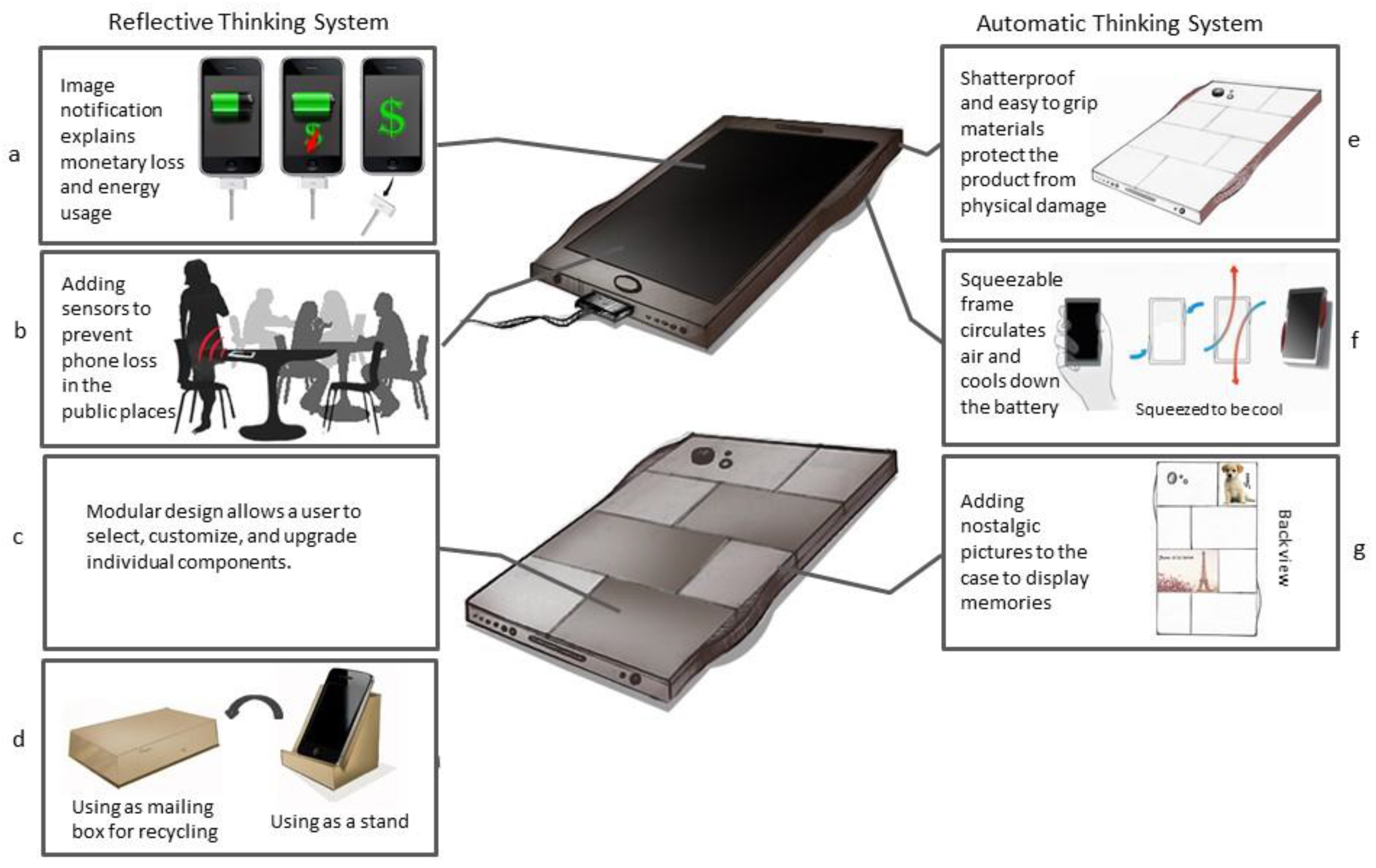
© 2016 by the authors; licensee MDPI, Basel, Switzerland. This article is an open access article distributed under the terms and conditions of the Creative Commons by Attribution (CC-BY) license (http://creativecommons.org/licenses/by/4.0/).
Share and Cite
Komeijani, M.; Ryen, E.G.; Babbitt, C.W. Bridging the Gap between Eco-Design and the Human Thinking System. Challenges 2016, 7, 5. https://doi.org/10.3390/challe7010005
Komeijani M, Ryen EG, Babbitt CW. Bridging the Gap between Eco-Design and the Human Thinking System. Challenges. 2016; 7(1):5. https://doi.org/10.3390/challe7010005
Chicago/Turabian StyleKomeijani, Mona, Erinn G. Ryen, and Callie W. Babbitt. 2016. "Bridging the Gap between Eco-Design and the Human Thinking System" Challenges 7, no. 1: 5. https://doi.org/10.3390/challe7010005





